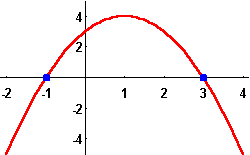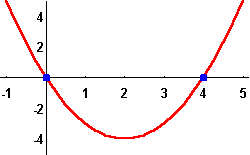 Solutions or Roots of Quadratic Equations
Solutions or Roots of Quadratic Equations  Solutions or Roots of Quadratic Equations
Solutions or Roots of Quadratic Equations

Consider the quadratic equation
![]()
A real number x will be called a solution or a root if it satisfies the equation, meaning ![]() . It is easy to see that the roots are exactly the x-intercepts of the quadratic function
. It is easy to see that the roots are exactly the x-intercepts of the quadratic function ![]() , that is the intersection between the graph of the quadratic function with the x-axis.
, that is the intersection between the graph of the quadratic function with the x-axis.
| |
|

| 
|
Example 1: Find the roots of the equation
![]()
Solution. This equation is equivalent to
![]()
Since 1 has two square-roots ![]() , the solutions for this equation are
, the solutions for this equation are
![]()
Example 2: Find the roots of the equation
![]()
Solution. This example is somehow trickier than the previous one but we will see how to work it out in the general case. First note that we have
![]()
Therefore the equation is equivalent to
![]()
which is the same as
![]()
Since 3 has two square-roots ![]() , we get
, we get
![]()
which give the solutions to the equation
![]()
We may then wonder whether any quadratic equation may be reduced to the simplest ones described in the previous examples. The answer is somehow more complicated but it was known for a very longtime (to the Babylonians about 2000 B.C. ). Their idea was based mainly on completing the square which we did in solving the second example.

 S.O.S MATHematics home page
S.O.S MATHematics home page Do you need more help? Please post your question on our S.O.S. Mathematics CyberBoard.

Author: Mohamed Amine Khamsi